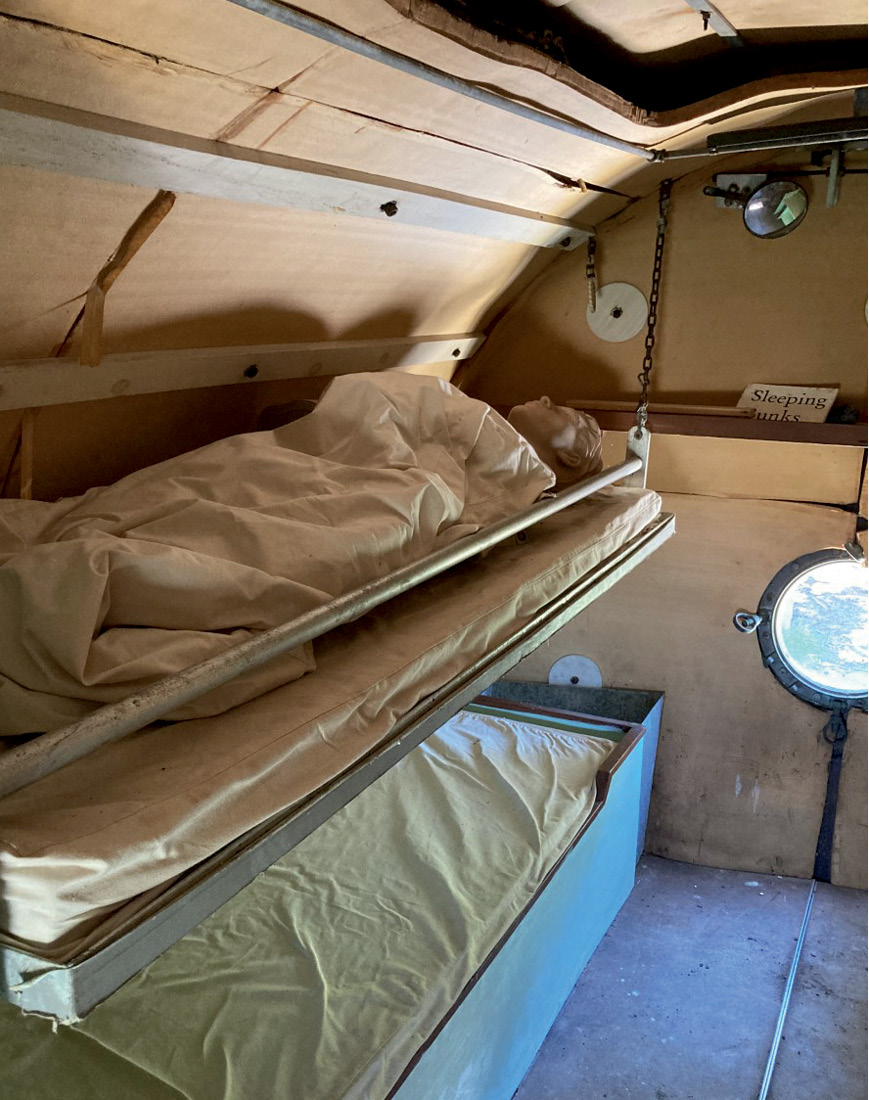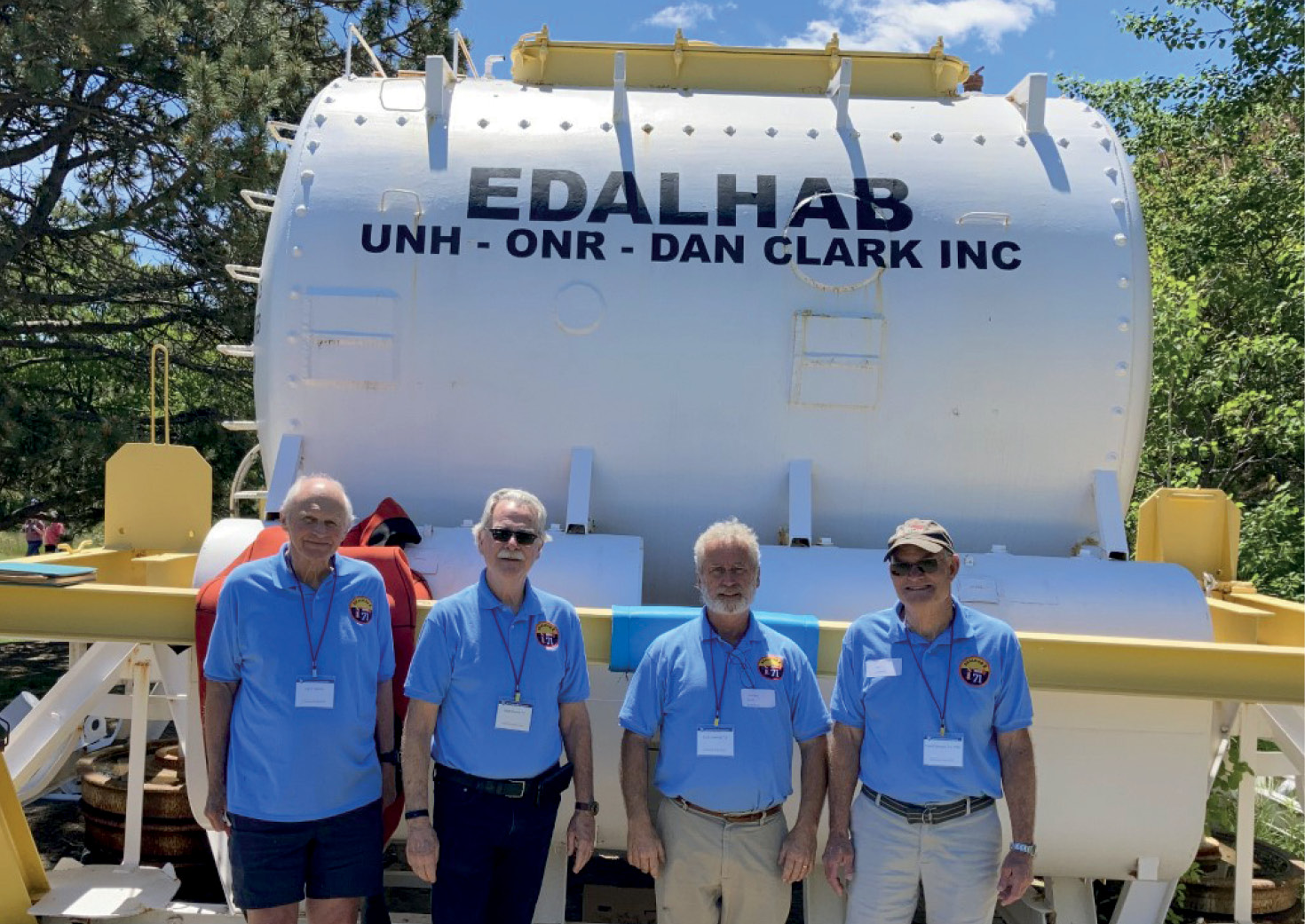Discovery in an undersea barrel
“We had no idea what we were in for when we signed up,” Glennon says, laughing.
In April 1971, Glennon and Sawtelle were tasked with monitoring how the Dungeness crab, a West Coast species, interacted with native species like lobster and wolffish in the Gulf of Maine. But the star of the show was EDALHAB, a portable underwater habitat that was constructed, in the words of former New Hampshire Congressman Louis C. Wyman, “by means of Yankee thrift and ingenuity.” A half-century later, it’s hard to believe that an 8-by-12 cramped metal tube stuffed with a set of bunk beds, two folding chairs and three exhausted students kicked off a marine science revolution.
“We were flying by the seat of our pants,” Sawtelle says. “But it had a big impact and it really put UNH on the map.”

Pickle Barrels and Moon Pools
EDALHAB, which stands for Engineering Design and Analysis Laboratory Habitat, was the brainchild of Jeff Savage, a professor of mechanical and ocean engineering. Constructed in 1968 in partnership with the Woods Hole Oceanographic Institution, EDALHAB was designed to accommodate underwater research projects that required diving in saturated conditions — an extended stay at any depth below 33 feet.
At that depth, air pressure doubles. When a diver breathes in gases from their tank, the air going into their lungs is at a higher atmospheric pressure. Over long periods of time, the diver’s body is saturated with diffused gases, especially nitrogen, and is in equilibrium with the environment. Returning to the surface requires decompression to ensure that the nitrogen doesn’t turn to gas, creating bubbles in the tissues and bloodstream — a dangerous condition known as decompression sickness, or “the bends.” Habitats like EDALHAB allowed divers to spend long periods of time underwater, having to return to the surface for only a single stint in a decompression chamber.
“It was the early days of research employing saturation diving,” Sawtelle says. “From a research standpoint, we were really guinea pigs. There hadn’t been a lot of evolution in terms of using saturation diving for underwater research yet.”
The habitat itself was something of an experiment. The vessel was an old chemical containment unit fondly dubbed “the pickle barrel” salvaged from Falmouth, Massachusetts, and the ballast tanks on the side of EDALHAB were 275-gallon oil tanks. EDALHAB’s inaugural deployment took place in Alton Bay in Lake Winnipesaukee in 1968, where student researchers spent 48 hours submerged in 20 feet of water. The habitat was idle for two years until Savage and zoology professor Larry Harris thought of using it for a larger project off the Isles of Shoals to study the Dungeness crab. The habitat was modified and redubbed EDALHAB II.
Getting EDALHAB II out to sea required the help of a massive team of personnel and support vessels. The Lulu, a support ship from Woods Hole Oceanographic Institution, transported the habitat to its location. “We had on these fairly thick, red dive suits,” Glennon says. “It was April and the water was cold. I peered down into the water and could see lights on in the habitat. We dove down, and I was the one who decided to poke my head in the moon pool, the entry door at the bottom of the habitat. The air pressure in the habitat was more than the ambient pressure down on the ocean floor. I took my mask off for the first breath of air, and I didn’t know if I was going to die instantly or be fine.”

Under Pressure and On a Schedule
“We didn’t sleep for more than 90 minutes for the whole four days,” Sawtelle says. “There was condensation everywhere, just dripping down. You’d pick up a notebook and it would just be dripping water.” Along with the damp, humid conditions, there was the noise. Air compressors on the support vessels pumped air down to the habitat below. Excess air bubbled up on the sides of the habitat and the noise was constant — an auto muffler was attached to the air hose in the habitat to dampen the sound.
The four days in EDALHAB II were physically and mentally exhausting. Though the three aquanauts were experienced divers physically capable of withstanding the stress and grueling schedule, Sawtelle thinks it was the trio’s mental attitudes that made the mission a success. “We were all pretty easygoing to start with,” he says. “And we were so busy that we didn’t have time to think about the difficulty.”
The project set the course for Glennon and Sawtelle’s careers. Glennon says his work on EDALHAB helped him land his first job with Normandeau Associates, a Bedford-based environmental consulting firm. Sawtelle went on to work as NOAA and New Hampshire Sea Grant’s first UNH marine aquaculture specialist. He now owns and operates Pinewoods Yankee Farm in Lee with his wife, Tina Fottler Sawtelle ’86.
The habitat itself wasn’t out of the water for long. In 1972, NOAA and UNH used it again for a series of experiments off the coast of Miami.
A Lasting Legacy
The “special projects” course that so intrigued Glennon and Sawtelle five decades ago evolved into TECH 797, a senior-level capstone class that has served as an incubator for exploring new and creative ideas in marine science research, according to Foster. New initiatives like the Center for Sustainable Seafood Systems (which recently launched thanks to a $5 million gift from the Emily Landecker Foundation) and the U.S. Department of Energy-sponsored Atlantic Marine Energy Center all grew out of TECH 797 projects.
“You’re going to see us continually grow in these areas,” she says. Whether it’s the restoration of salt marshes in the Hampton/Seabrook estuary, monitoring marine ecosystem health or developing aquaculture systems that could feed the planet, Foster believes UNH will be key to finding sustainable solutions to challenges both global and local. “We need engineers and physical scientists and life scientists and ecologists all coming together to focus on this work,” she says. “At UNH, we have students and faculty looking at these issues from all of these disciplinary perspectives.”